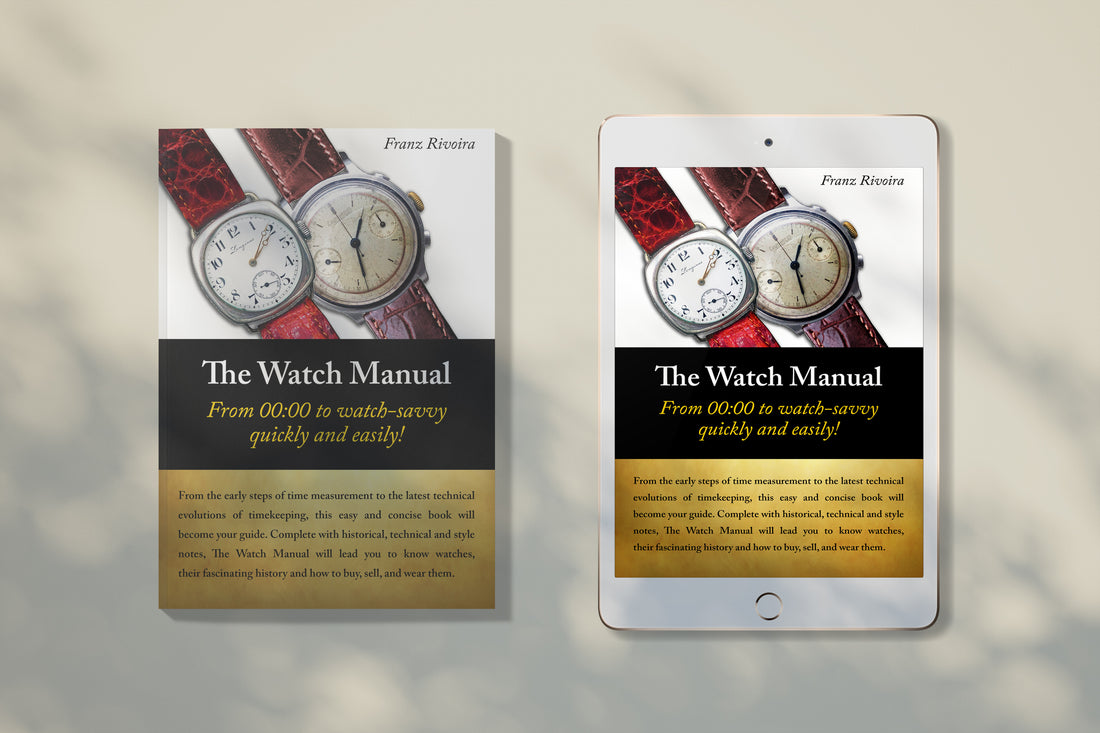
The Watch Manual: the fascinating stories behind watches and watchmaking in a book
From Vintage Classics to Modern Marvels: The Must-Have Watch Book for Timepiece Enthusiasts
Step into the enchanting world of timekeeping with 'The Watch Manual.' This captivating book delves deep into the history of horology. It uncovers the secrets and anecdotes that lie behind some of the world's most iconic timepieces and brands.
From the legendary craftsmanship of Swiss watchmakers to the innovative design of modern masterpieces, this book is a treasure trove for watch enthusiasts and history buffs alike. Immerse yourself in the tales of daring feats and technological breakthroughs that have shaped the evolution of watches throughout the centuries.
With clear, fitting images and in-depth explanations, 'The Watch Manual’ showcases the intricate artistry and intricate craftsmanship behind each timepiece. Discover the stories behind the timeless classic brands and the legendary figures who have made an indelible mark on the watchmaking industry.
Whether you're a seasoned collector or simply captivated by the elegance and precision of vintage and modern timepieces, 'The Watch Manual’ is the watch book that offers a fascinating exploration into the world of timekeeping, revealing the remarkable stories that have stood the test of time.

To learn more about watches, buy The Watch Manual here
The history of watchmaking
The Watch Manual will explain you about the history of horology. Watchmaking history is a fascinating journey that spans centuries. It all began at the end of the 14th century with the invention of first mechanical clocks; it eventually led to the development of portable timekeeping devices. The first watches were bulky and inaccurate, but they laid the foundation for the intricate, accurate timepieces we can enjoy today at our wrists.
From the 16th century, watchmaking industry diffused in Germany, France, England, and Switzerland, thanks to the precision and craftsmanship of the artisans in the region. Watchmakers around Europe perfected the art of watchmaking, and their reputation for excellence still holds true to this day. The watchmaking industry continued to evolve, with the introduction of new technologies and the creation of more refined and accurate timepieces.

Grasshopper escapement
Notable watchmakers and their contributions
Throughout history, there have been several watchmakers who have left an indelible mark on the industry. One such figure is Abraham-Louis Breguet, often referred to as the "father of modern watchmaking." Breguet revolutionized the industry with his groundbreaking inventions, including the tourbillon and the self-winding mechanism.

Tourbillon Breguet (photo from Breguet.com)
Another legendary watchmaking Maison is Patek Philippe, known for its exceptional craftsmanship and timeless designs. Patek Philippe watches have adorned the wrists of royalty, celebrities, and watch enthusiasts alike. Its commitment to quality and innovation has made Patek Philippe one of the most prestigious watch brands in the world. But you’ll discover it along 65 other protagonists of watchmaking in the pages of ‘The Watch Manual’.

Jewel watches Patek Philippe
Iconic watches and their stories in a pocket book
Some watches have become iconic symbols of luxury, precision, and style. The Rolex Submariner, for example, is a legendary timepiece that was originally designed for divers. Its robust construction and waterproof capabilities made it an instant favorite among adventurers and watch aficionados.

Rolex Submariner (photo from Rolex.com)
The Omega Speedmaster is another iconic watch that holds a special place in history. It was the first watch worn on the moon during the Apollo 11 mission. The Speedmaster's reliability and accuracy have made it a favorite among astronauts and space enthusiasts – as well as horology lovers. You will discover these timepieces, and their history in The Watch Manual.
The book on the evolution of watch designs
Over the years, watch designs have evolved to reflect changing tastes and trends. From the classic elegance of pocket watches to the bold and sporty aesthetics of modern timepieces, there is a watch for every style and occasion.
In the early 20th century, wristwatches replaced pocket watches as the preferred choice for timekeeping. The introduction of quartz technology in the 1970s revolutionized the industry, making watches more accurate and affordable. Today, watch designs continue to push the boundaries of innovation, with new materials and intricate complications.
The significance of complications in watches
Complications refer to any additional feature or function on a watch besides timekeeping. These can include features like calendars, moon phases, chronographs, and tourbillons. Complications not only add complexity to a timepiece but also showcase the craftsmanship and technical prowess of the watchmaker. The Watch Manual is the best watch book to accompany you in this fascinating world of perfection.
To learn more about watches, buy The Watch Manual here
Complications serve both practical and aesthetic purposes. They provide useful information to the wearer, such as the date or the phases of the moon, while also enhancing the visual appeal of the watch. Complicated watches are highly sought after by collectors and connoisseurs for their rarity and complexity.
Collecting watches as a hobby
Collecting watches has become a popular hobby among individuals who appreciate the artistry and history behind these timepieces. Watch collectors often seek out limited-edition models, vintage pieces, or watches with unique complications. Building a watch collection can be a lifelong pursuit, as there are always new and interesting timepieces to discover – and The Watch Manual is the best watch book reference to help you organize and select the best timepieces to include in your collection.
Collecting watches goes beyond just owning beautiful timepieces. It requires knowledge of the industry, an understanding of watchmaking techniques, and an appreciation for the stories behind each watch. A well-curated watch collection can be a reflection of one's personal style and passion for horology.
The cultural impact of watches
Watches have long been more than just timekeeping devices. They have become symbols of status, luxury, and craftsmanship. In many cultures, watches are considered heirlooms that are passed down through generations, carrying with them the stories and memories of the past.
Watches have also played significant roles in literature, film, and popular culture. From James Bond's iconic Rolex Submariner to the timeless elegance of Audrey Hepburn's Cartier Tank, watches have become iconic symbols in their own right. They have become part of our collective imagination and continue to capture the hearts of watch enthusiasts around the world – and The Watch Manual is the best watch book to introduce you to this world of beauty.

Cartier Tank (photo from Cartier.com)
Behind the scenes of horology with "The Watch Manual"
'The Watch Manual' is a book that offers a unique behind-the-scenes look at the making of this extraordinary industry. From the meticulous research to the stunning descriptions, every aspect of the book is a testament to the passion and dedication of the author – with his over 33 million views, one of the leading writers about horology on Quora - and his vast horological knowledge.
The book features profiles with renowned watchmakers, models, and brands, providing an insider's perspective on the world of horology. It offers a glimpse into the hidden stories and fascinating anecdotes that make each watch truly special. 'The Watch Manual is a celebration of the artistry and craftsmanship that goes into creating these extraordinary timepieces.
Conclusion: The enduring allure of timepieces
As ' The Watch Manual’ reveals, watches are not just instruments for measuring time; they are works of art, symbols of human ingenuity, and bearers of stories that transcend generations.
From the earliest mechanical clocks to the cutting-edge creations of today, watches have always captivated our imagination and represented our desire to measure, capture, and cherish time. They have become more than just objects; they are treasures that connect us to the past and inspire us to embrace the future.
Whether you are a seasoned collector or simply captivated by the elegance and precision of watches, 'The Watch Manual’ is the watch book that offers a unique exploration into the world of timekeeping, revealing the remarkable stories that have stood the test of time. Step into this enchanting world and discover the captivating tales that lie behind each tick and tock.
To learn more about watches, buy The Watch Manual here
The Watchonomicon is an independent blog, written and managed by The Watch Manual. The Watch Manual is NOT affiliated in any way with any brand mentioned in articles.
